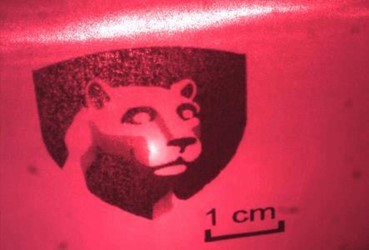Princeton, Penn State Researchers Create Diode Laser From Hybrid Perovskite Material
By Jof Enriquez,
Follow me on Twitter @jofenriq

Scientists at Pennsylvania State University and Princeton University have created a diode laser from hybrid organic-inorganic perovskites – materials that have garnered attention due to their light emitting properties, useful in optoelectronic devices and solar cells.
In use for many decades now, conventional laser diodes are made from inorganic semiconductors grown in elaborate high vacuum systems. They are rather limited in the wavelengths of light they emit, though. So, instead, scientists have been looking to use organic semiconductors to make lasers that produce any wavelength just by tailoring the structure of the organic molecules. This tunability, plus the fact that organic semiconductors can flex easily, make these lasers ideal for medical diagnostics or environmental sensing.
No purely organic laser diode has been made yet, but Penn State and Princeton researchers may be a step closer to making one a reality. They have been experimenting with perovskite minerals, which create semiconductors that are very stable and have tunable band gaps — ideal as light-absorbing materials in photovoltaic cells — and have emerged as a promising gain media for creating lasers. Specifically, the researchers used a hybrid form consisting of an inorganic perovskite sublattice with relatively big organic molecules confined in the middle.
However, optically pumping this hybrid material could only yield very short pulses due to a poorly understood phenomenon called lasing death. But the researchers discovered a peculiar way to avoid lasing death by cooling the material to trigger a partial phase transition.
"When we lowered the temperature below the phase transition, we were surprised to find that the material initially emitted light from the low temperature phase, but then changed over within 100 nanoseconds and began lasing from the high-temperature phase — for over an hour," said Yufei Jia, a graduate student and lead author of the paper published in the journal Nature Photonics.
"It turned out that as the material heated up, although most of the material remained in the low-temperature phase, small pockets of the high-temperature phase formed, and that was where the lasing was coming from," said Jia.
The sustained lasing might be explained by high-temperature-phase inclusions in the perovskite material, which mimic quantum wells in inorganic lasers that trap charge carriers responsible for the lasing.
"In this mixed-phase system, the tetragonal inclusions function as carrier recombination sinks that reduce the transparency threshold, in loose analogy to inorganic semiconductor quantum wells, and may serve as a model for engineering improved perovskite gain media," the researchers wrote in the paper co-authored by Ross A. Kerner, Alex J. Grede, Barry P. Rand, and Noel C. Giebink.
In the paper, Continuous-wave lasing in an organic–inorganic lead halide perovskite semiconductor, they propose some ideas to create materials with the same built-in qualities of this mixed- phase arrangement, but without having to actually cool the material to low temperature. The next big step, according to the researchers, is to switch from optical pumping with an external laser to a perovskite laser diode that can be powered directly with electrical current.
"The ultimate goal is to make an electrically driven perovskite laser diode," said Giebink. "That would be a game changer."
